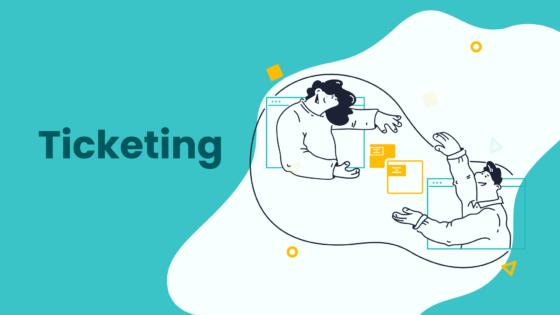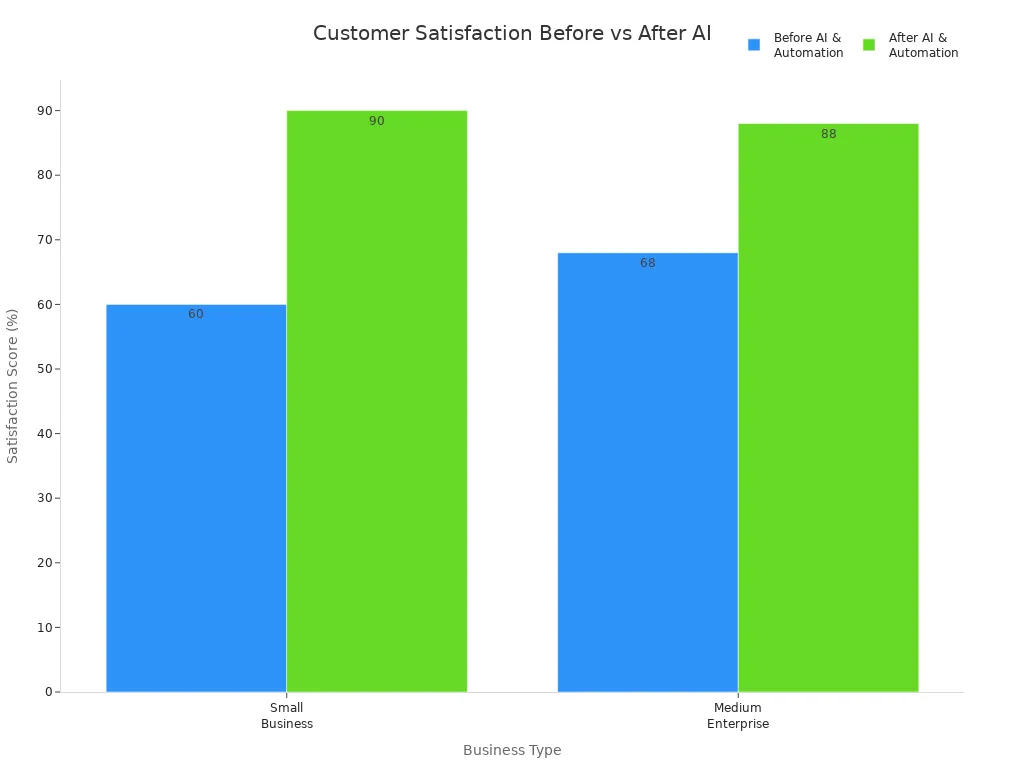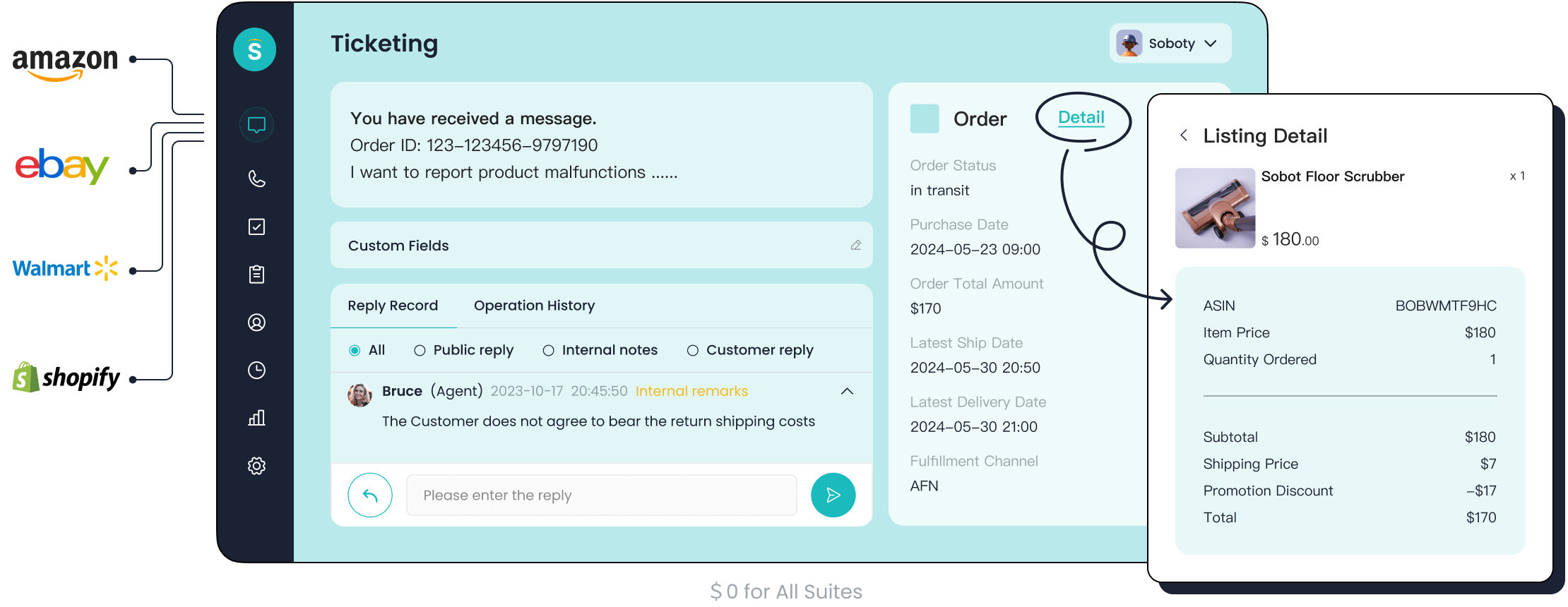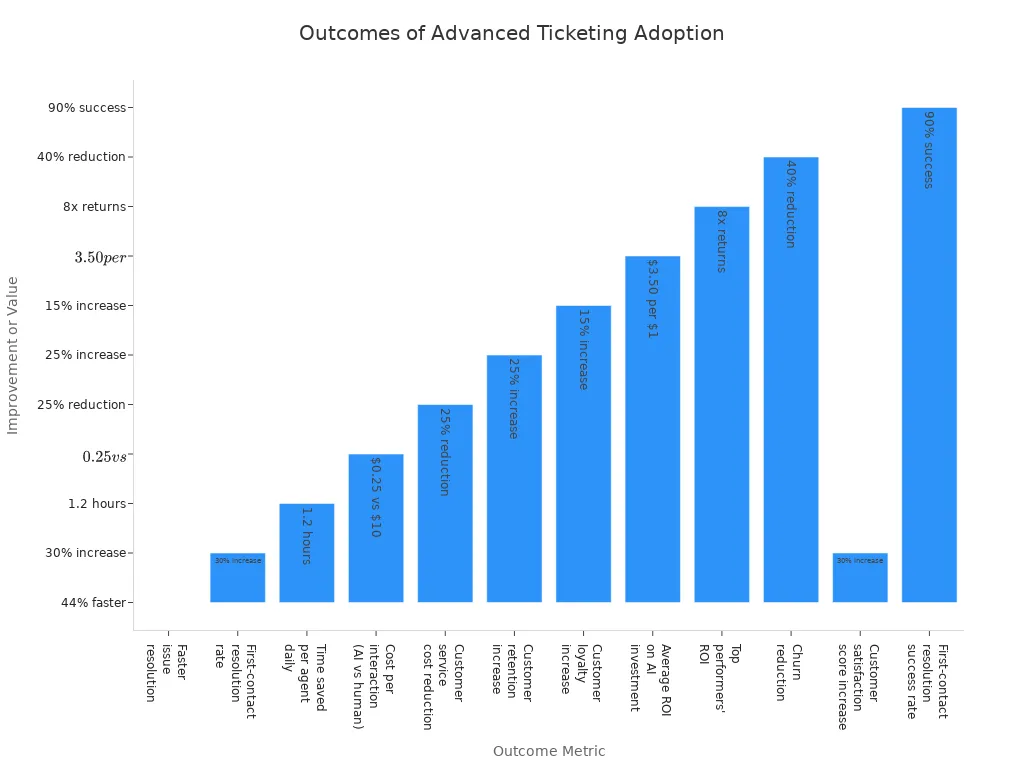The Future of Automated Ticketing Systems Unveiled

The future of automated ticketing system technology centers on speed, intelligence, and seamless customer experiences. Organizations see a major shift as AI, automation, and omnichannel support reshape customer service. Data shows that after adopting automation and AI, businesses report customer satisfaction scores rising from 60% to over 90%, with response times dropping from days to hours.

Emerging trends reveal that integrated ticketing systems, like those from Sobot, empower customer support teams to manage all service channels on one cloud-based ticketing system. Sobot AI helps organizations deliver faster resolutions and maintain high customer satisfaction. Companies that embrace these future-focused ticketing solutions stay ahead in service delivery and customer loyalty.
Trends in Automated Ticketing Systems

The automated ticketing system landscape in 2025 reflects rapid change, driven by new technologies and shifting customer expectations. Industry analysts highlight several emerging trends that shape the future of ticketing systems:
- Open distribution strategies now enable multichannel ticket sales, boosting inventory turnover and reducing fraud.
- Accessibility and inclusivity have become priorities, with features like ADA compliance and voice-activated ticketing.
- Contactless ticketing technologies, such as NFC and mobile wallets, improve security and convenience.
- AI tools and real-time data optimize the customer journey and venue operations.
- Venue mapping and reserved seating technology create customizable experiences and operational efficiency.
Sobot stands out as an industry leader by integrating these advancements into its unified, cloud-based ticketing system. The company’s AI-first approach and focus on omnichannel solutions help organizations deliver seamless customer support and superior user experience and support.
AI and Automation
AI and advanced automation have transformed ticketing systems. Companies now use AI-powered systems to automate ticket assignment, response generation, and workflow automation. Smart chatbots resolve up to 80% of routine inquiries instantly, freeing agents to handle complex issues. For example, Sobot’s automated ticketing system uses intelligent routing and SLA management to reduce response times by up to 70%. This approach increases agent productivity by 25-40% and ensures customers receive faster, more accurate service. Generative AI and large language models further enhance ticketing by enabling context-aware responses and self-service options. These advancements help organizations scale customer support and maintain high satisfaction rates.
Omnichannel Integration
Omnichannel integration has become essential for consistent customer support. Modern ticketing systems connect all communication channels—email, chat, phone, and social media—into a single, unified conversation. Customers can switch between channels without repeating information, as agents have access to the full customer history. Sobot’s omnichannel solution provides a unified workspace, allowing agents to manage all interactions efficiently. This seamless integration builds trust and loyalty by valuing customer time and effort. Omnichannel platforms also increase efficiency by consolidating communication, supporting workflow automation, and enabling real-time responses. Businesses benefit from improved agent productivity and a more consistent customer experience.
Historical Data Utilization
Historical data plays a critical role in automated ticketing systems. By analyzing past tickets, customer behavior, and market trends, organizations can forecast demand, optimize inventory, and personalize service. Leading ticketing systems use AI to categorize, prioritize, and route tickets based on historical patterns, improving accuracy and reducing manual workload. Sobot’s ticketing platform leverages historical data to enhance predictive analytics, enabling proactive problem-solving and dynamic resource allocation. This approach minimizes risks, maximizes revenue, and supports personalized customer experiences. Combining historical data with workflow automation ensures faster resolutions and higher customer satisfaction.
Sobot Ticketing System Advantages

Unified Platform
Sobot delivers a unified platform that brings all customer channels and communication methods together. This approach eliminates the need for multiple systems and reduces complexity for support teams.
- The platform integrates email, chat, phone, and even e-commerce platforms like Shopify and Amazon.
- Sobot’s "AI-First" strategy uses five types of AI, including omnichannel and generative AI, to enhance every customer interaction.
- Over 300 statistical reports help teams track thousands of indicators, making it easy to monitor performance.
- The platform supports customization and APIs, allowing businesses to tailor the system to their needs.
- Sobot’s pricing remains competitive, often costing half as much as other ticketing systems, with no hidden fees.
Sobot’s unified platform covers the full customer journey, from sales to support, ensuring every customer receives consistent service. This all-in-one solution helps organizations streamline workflow automation and improve operational efficiency.
Intelligent Routing
Sobot’s intelligent routing ensures every customer inquiry reaches the right agent or department.
- The system uses AI and machine learning to analyze each ticket and match it with the most qualified agent.
- This targeted approach reduces response times and balances workloads across the team.
- Automation features prioritize and assign tickets, so urgent issues get immediate attention.
- Support teams benefit from streamlined workflows, which leads to faster resolutions and higher customer satisfaction.
For example, when a customer submits a request through the self-service portal, Sobot’s intelligent routing directs it to the best agent based on expertise and availability. This process minimizes wait times and ensures customers receive timely, relevant assistance.
SLA and Analytics
SLA management and analytics play a vital role in Sobot’s ticketing systems.
- SLA metrics—such as response time, resolution time, and customer satisfaction score—provide clear indicators of support performance.
- Automation ensures teams meet SLA targets by sending reminders and escalating unresolved tickets.
- Analytics tools track average response times and first contact resolution rates, helping teams set improvement goals.
- Centralized dashboards organize tickets by priority and category, making ticket management more efficient.
Regular review of SLA data enables continuous improvement. Sobot’s analytics and workflow automation help teams deliver faster responses, prevent SLA breaches, and build trust with every customer.
Cloud-Based Ticketing Systems
Scalability and Security
Cloud-based ticketing systems help businesses grow without the need for expensive hardware or complex upgrades. Companies can increase their support capacity by simply adjusting their subscription plans. The table below shows the main differences between on-premises and cloud-based solutions:
| Aspect | On-Premises Solutions | Cloud-Based Solutions |
|---|---|---|
| Scalability | Requires costly infrastructure upgrades and licensing | Easily scalable by upgrading plans without extra infrastructure |
| Cost | High due to infrastructure, maintenance, and licenses | Lower costs with subscription model paying only for needed features |
Cloud-based ticketing systems also provide strong security. Providers like Sobot follow strict industry standards and offer features such as role-based access control, multi-factor authentication, and data encryption. Enterprises benefit from automatic updates and regular audits, which help protect sensitive information and ensure compliance with regulations. This approach allows organizations to focus on customer service while trusting the provider to manage security and privacy.
Integration with E-commerce
Many businesses rely on e-commerce platforms to serve customers. Cloud-based ticketing systems, such as Sobot’s, integrate smoothly with platforms like Shopify and Amazon. This integration allows support teams to view order details, track customer issues, and resolve problems quickly. However, some challenges may arise, including compatibility issues, limited testing environments, and managing high data loads. Companies must ensure seamless data synchronization and error handling to maintain transparency and efficiency. Sobot’s ticketing systems address these challenges by offering robust APIs and real-time data sync, which help teams deliver fast, accurate support.
Real-Time Reporting
Real-time monitoring and reporting are essential features of modern cloud-based ticketing systems. These tools give managers instant access to key metrics, such as ticket volume, response times, and customer satisfaction scores. Sobot’s platform provides over 300 statistical reports, helping teams identify trends and make data-driven decisions. With real-time insights, organizations can spot issues early, adjust resources, and improve service quality. This level of visibility supports continuous improvement and ensures customers receive timely, effective support.
Event Ticketing Innovations

Anti-Bot Security
Event ticketing faces constant threats from bots that disrupt ticket sales and damage the customer experience. Modern event ticketing systems now use advanced anti-bot security to protect both organizers and attendees.
- AI-driven CAPTCHA solutions adapt to new attack methods by analyzing user behavior and using multi-factor authentication.
- Device fingerprinting and real-time risk monitoring help detect and flag suspicious activity instantly.
- Blockchain ticketing and NFT-based tickets create tamper-proof, transparent validation, stopping counterfeit tickets.
- Dynamic pricing algorithms and purchase limits per buyer reduce scalper profits and prevent mass purchases.
- Personalized ticketing links tickets to individual identities, often using biometric verification, to block unauthorized resale.
- Verified fan access programs require pre-registration and screening, keeping bots out before ticket sales begin.
Platforms like Sobot support these advancements by integrating robust anti-bot measures and ensuring fair, secure ticket sales for all events. Contactless ticketing and mobile ticketing further enhance security and convenience for attendees.
Personalized Experiences
Personalization has become a key driver in event ticketing. AI-powered recommendations suggest sessions based on user profiles, while QR code ticketing enables seamless entry. For example, a global tech summit saw a 40% increase in ticket sales during pre-launch and a 25% reduction in no-shows after implementing personalized ticketing. Ninety percent of attendees rated their customer experience as excellent.
Personalized post-event follow-ups, such as thank-you emails referencing specific sessions, make attendees feel valued. Exclusive content and early-bird discounts encourage repeat attendance. By analyzing ticketing data, organizers can optimize event logistics and communications, leading to smoother events and higher satisfaction.
Hybrid Event Support
Hybrid events combine in-person and virtual experiences, expanding reach and flexibility. Modern event ticketing systems manage both physical and virtual attendees with automated reminders and virtual platform integrations.
Key features include:
- Integrated registration and ticketing for all attendee types
- Multiple ticketing options, such as tiered pricing and group rates
- Real-time video streaming and interactive tools like live Q&A, polls, and chat
- Analytics to track engagement and measure event ROI
These advancements help organizers attract larger, more diverse audiences and deliver a superior customer experience. Sobot’s omnichannel solutions support hybrid events by unifying ticket sales, contactless ticketing, and attendee engagement across all channels.
Customer Success Stories
OPPO and Sobot
OPPO, a global leader in smart devices, partnered with Sobot to transform its customer service operations. The company faced high volumes of inquiries during major shopping events, which challenged its ability to maintain high satisfaction and retention. Sobot introduced an AI-powered ticketing and live chat system that streamlined customer interactions and improved efficiency. The following table shows the measurable outcomes OPPO achieved after implementing Sobot’s solution:
| Measurable Outcome | Result |
|---|---|
| Chatbot resolution rate | 83% |
| Positive feedback score | 94% |
| Increase in repeat purchases | 57% |
These results highlight how OPPO improved customer satisfaction, increased retention, and built stronger customer loyalty through advanced automation and seamless service.
Efficiency Gains
Organizations that adopt automated ticketing systems like Sobot’s experience significant efficiency gains.
- AI-driven automation delivers up to 50% time savings and 40% cost savings.
- The time to benefit for these solutions is less than six months, showing rapid improvements.
- Productivity increases by a factor of 1.5, allowing teams to handle more customer requests during busy events.
A recent report found that employees using high-impact automation save about 200 hours each year. This efficiency allows support teams to focus on complex customer needs, leading to better satisfaction and higher retention rates.
Customer Satisfaction
Companies measure customer satisfaction using several key metrics. The table below outlines the most important ones:
| Metric Name | Purpose / What it's good for | Formula / Calculation Example |
|---|---|---|
| First Response Time (FRT) | Measures how quickly a support rep responds to a customer inquiry, impacting satisfaction. | FRT = Total first response time for all tickets ÷ Total number of interactions. Example: 500 min ÷ 100 = 5 min. |
| First Contact Resolution (FCR) | Percentage of customer queries resolved in the first interaction, indicating efficiency. | FCR (%) = (Number of issues resolved in first contact ÷ Total issues) × 100. Example: (80 ÷ 100) × 100 = 80%. |
| Customer Satisfaction Score (CSAT) | Gauges customer happiness via surveys, identifying strengths and improvement areas. | CSAT (%) = (Number of satisfied customers rating 4 or 5 ÷ Total responses) × 100. Example: (80 ÷ 100) × 100 = 80%. |
| Net Promoter Score (NPS) | Measures likelihood of customers recommending the service, reflecting loyalty and satisfaction. | Categorizes customers by rating 0-10 into detractors, passives, and promoters. |
Sobot’s platform helps organizations track these metrics in real time, ensuring every customer receives prompt, effective service. High satisfaction scores and improved retention rates show the value of investing in advanced customer support solutions for all types of events.
Practical Steps for Organizations
Upgrading Legacy Systems
Organizations planning to modernize their IT ticketing system should start with a thorough assessment. Teams gather requirements and review current workflows before making changes. Many companies choose a modular or full rewrite approach to improve user experience and streamline processes. Integrating the IT ticketing system with platforms like CRM and automation tools increases customer engagement and provides better data insights. Cloud-based solutions, such as Sobot’s IT ticketing system, offer scalability, strong data protection, and easy backup features. Collaboration with experienced partners ensures smooth API integration and milestone-driven progress.
Real-world examples show that modernization leads to higher efficiency and greater user satisfaction. Continuous improvement and clear user manuals help teams adapt quickly and succeed in the long term.
Compliance and Security
Security and compliance remain top priorities for any IT ticketing system. Companies must protect customer data and follow industry regulations. Sobot’s IT ticketing system uses role-based access control, multi-factor authentication, and data encryption to keep information safe. Regular audits and automatic updates help organizations stay compliant with changing standards.
| Security Feature | Benefit |
|---|---|
| Data Encryption | Protects customer information |
| Role-Based Access | Limits data exposure |
| Multi-Factor Authentication | Prevents unauthorized access |
| Regular Audits | Ensures ongoing compliance |
These features support IT service management goals and build trust with every customer.
Team Training
Proper training helps support teams get the most from a new IT ticketing system. Companies should prioritize system training during onboarding. Simulated tickets allow new agents to practice in a safe environment. Supervisors review responses before agents handle real customer issues. A buddy system pairs new hires with experienced agents for guidance and support.
These steps boost agent confidence and efficiency, leading to better customer service and higher satisfaction. Sobot provides resources and support to help teams master its IT ticketing system and deliver excellent service.
The future of automated ticketing systems brings remarkable innovations for organizations managing events. Key advancements include biometric verification, contactless ticketing, and AI-powered analytics that personalize experiences and optimize event management.
- Blockchain and open distribution strategies enhance security and flexibility.
- Cloud migration modernizes legacy systems, ensuring scalability and reliability.
Sobot’s AI-driven solutions deliver measurable results, such as a 30% increase in customer satisfaction and up to 90% first-contact resolution rates.

Organizations should regularly evaluate their ticketing systems by collecting feedback, monitoring performance, and analyzing data. Sobot’s cloud-based platform empowers teams to manage all events efficiently and achieve higher satisfaction. For tailored advice or a demo, contact Sobot and discover how to elevate your next events.
FAQ
What is an automated ticketing system?
An automated ticketing system uses software to manage customer inquiries. It assigns, tracks, and resolves tickets without manual effort. Sobot’s automated ticketing system handles over 6 million online communications daily, helping businesses respond faster and improve customer satisfaction.
How does Sobot’s automated ticketing system improve efficiency?
Sobot’s automated ticketing system uses AI to route tickets, send reminders, and automate responses. Teams save up to 40% of their time. This efficiency allows agents to focus on complex issues and deliver better service.
Can Sobot’s automated ticketing system integrate with e-commerce platforms?
Yes, Sobot’s automated ticketing system integrates with platforms like Shopify and Amazon. Support teams can view order details and resolve issues quickly. This integration streamlines workflows and boosts customer satisfaction.
Is Sobot’s automated ticketing system secure?
Sobot’s automated ticketing system uses data encryption, role-based access, and multi-factor authentication. Regular audits ensure compliance with industry standards. Businesses trust Sobot to protect sensitive customer information.
Why should organizations upgrade to an automated ticketing system?
Organizations using automated ticketing systems report a 30% increase in customer satisfaction and up to 90% first-contact resolution rates. Sobot’s automated ticketing system helps companies scale support, reduce costs, and deliver consistent service across all channels.
Tip: For more details on Sobot’s automated ticketing system, visit Sobot’s official website.
See Also
Best Automated Voice Call Platforms Evaluated For 2024
Analyzing Artificial Intelligence Solutions For Enterprise Call Centers
Comparing Leading Interactive Voice Response Systems Today
Understanding The Efficiency Behind Call Center Automation
Ways Artificial Intelligence Enhances Customer Service Performance
